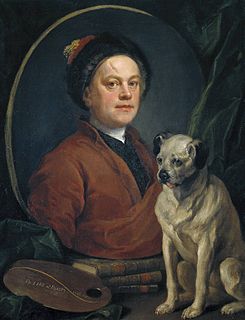
Murray Seafield St George Head is an English actor and singer. Head has appeared in a number of films, including the role of Bob Elkin in the Oscar-nominated 1971 film Sunday Bloody Sunday. As a musician, he is most recognised for his international hit songs "Superstar" and "One Night in Bangkok", and for his 1975 album Say It Ain't So. He has been involved in several projects since the 1960s and continues to record music, perform concerts, and make appearances on television either as himself or as a character actor.

Georg Christoph Lichtenberg was a German physicist, satirist, and Anglophile. As a scientist, he was the first to hold a professorship explicitly dedicated to experimental physics in Germany. He is remembered for his posthumously published notebooks, which he himself called Sudelbücher, a description modelled on the English bookkeeping term "scrapbooks", and for his discovery of tree-like electrical discharge patterns now called Lichtenberg figures.

Martin van Butchell (1735–1814) was an eccentric British dentist who put his dead wife on display, reputedly because of a clause in a marriage contract.

Claude of France was a queen consort of France by marriage to Francis I. She was also ruling Duchess of Brittany from 1514. She was a daughter of the French king Louis XII and Anne of Brittany.
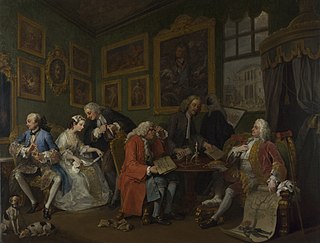
Marriage A-la-Mode is a series of six pictures painted by William Hogarth between 1743 and 1745 depicting a pointed skewering of upper class 18th century society. This moralistic warning shows the disastrous results of an ill-considered marriage for money and satirises patronage and aesthetics. The pictures are exhibited in the National Gallery, London.
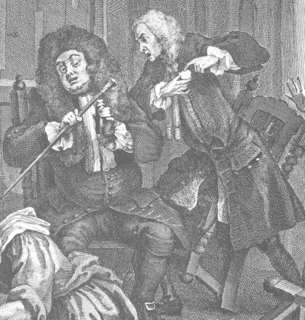
John (Jean) Misaubin was an 18th-century Huguenot French and British physician and "quack."

Frédéric Prinz von Anhalt is a German-American entrepreneur best known as the last husband and widower of Zsa Zsa Gabor. He took on his new name at age 36 in 1980, after Princess Marie-Auguste of Anhalt, then in her 80s, adopted him as an adult.
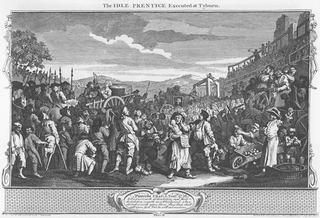
Industry and Idleness is the title of a series of 12 plot-linked engravings created by William Hogarth in 1747, intending to illustrate to working children the possible rewards of hard work and diligent application and the sure disasters attending a lack of both. Unlike his earlier works, such as A Harlot's Progress (1731) and Marriage à-la-mode (1743), which were painted first and subsequently converted to engravings, Industry and Idleness was created solely as a set of engravings. Each of the prints was sold for 1 shilling each so 12 for the entire set, which is equivalent in purchasing power to approximately 80 GBP as of 2005. It may be assumed that these prints were aimed for a wider and less wealthy market than his earlier works. The originals currently reside at the British Museum.
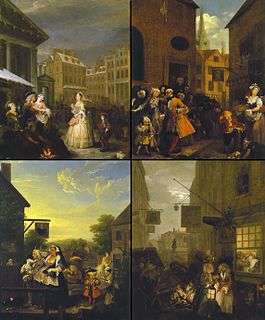
Four Times of the Day is a series of four oil paintings by English artist William Hogarth. Completed in 1736, they were reproduced as a series of four engravings published in 1738. They are humorous depictions of life in the streets of London, the vagaries of fashion, and the interactions between the rich and poor. Unlike many of Hogarth's other series, such as A Harlot's Progress, A Rake's Progress, Industry and Idleness, and The Four Stages of Cruelty, it does not depict the story of an individual, but instead focuses on the society of the city. Hogarth intended the series to be humorous rather than instructional; the pictures do not offer a judgment on whether the rich or poor are more deserving of the viewer's sympathies: while the upper and middle classes tend to provide the focus for each scene, there are fewer of the moral comparisons seen in some of his other works. Their dimensions are about 74 cm (29 in) by 61 cm (24 in) each.

The Marriage Settlement is the first in the series of six satirical paintings known as Marriage à-la-mode painted by William Hogarth.

The Toilette, called The countess’s morning levee by Hogarth himself, is the fourth canvas in the series of six satirical paintings known as Marriage A-la-Mode painted by William Hogarth.

The Bagnio is the fifth canvas in the series of six satirical paintings known as Marriage à-la-mode painted by William Hogarth.

The Lady's Death is the sixth and final canvas in the series of satirical paintings known as Marriage à-la-mode painted by William Hogarth.
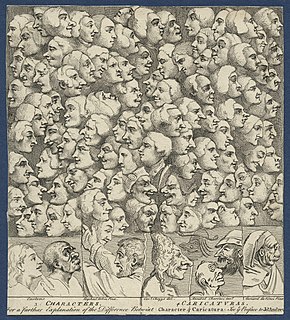
Characters and Caricaturas is an engraving by English artist William Hogarth, that he produced as the subscription ticket for his 1743 series of prints, Marriage à-la-mode, and which was eventually issued as a print in its own right. Critics had sometimes dismissed the exaggerated features of Hogarth's characters as caricature and, by way of an answer, he produced this picture filled with characterisations accompanied by a simple illustration of the difference between characterisation and caricature.

The Bench is the title of both a 1758 oil-on-canvas painting by the English artist William Hogarth, and a print issued by him in the same year. Unlike many of Hogarth's engravings produced from painted originals, the print differs considerably from the painting. It was intended as a demonstration of the differences between character painting, caricature and outré—developing on the theme he had begun to address in Characters and Caricaturas —but Hogarth was unhappy with the result as it showed only "characters", and he continued to work on the piece until his death.
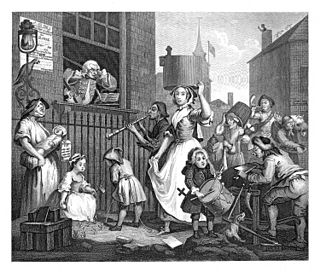
The Enraged Musician is a 1741 etching and engraving by English artist William Hogarth which depicts a comic scene of a violinist driven to distraction by the cacophony outside his window. It was issued as companion piece to the third state of his print of The Distrest Poet.

Beer Street and Gin Lane are two prints issued in 1751 by English artist William Hogarth in support of what would become the Gin Act. Designed to be viewed alongside each other, they depict the evils of the consumption of gin as a contrast to the merits of drinking beer. At almost the same time and on the same subject, Hogarth's friend Henry Fielding published An Inquiry into the Late Increase in Robbers. Issued together with The Four Stages of Cruelty, the prints continued a movement started in Industry and Idleness, away from depicting the laughable foibles of fashionable society and towards a more cutting satire on the problems of poverty and crime.

